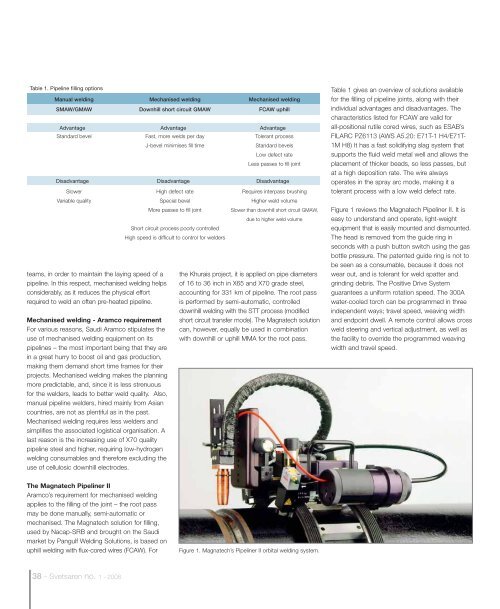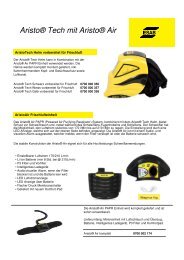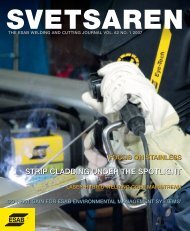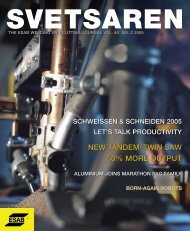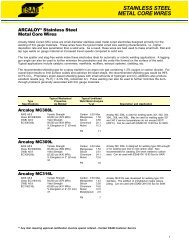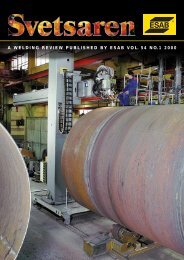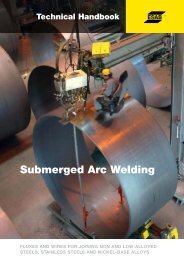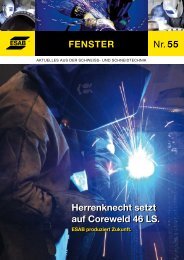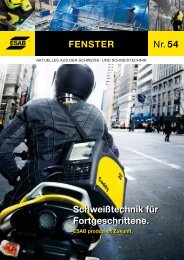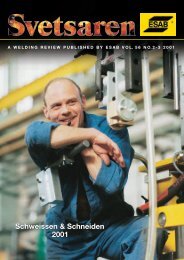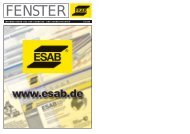You also want an ePaper? Increase the reach of your titles
YUMPU automatically turns print PDFs into web optimized ePapers that Google loves.
Table 1. Pipeline filling options<br />
Manual welding Mechanised welding Mechanised welding<br />
SMAW/GMAW Downhill short circuit GMAW FCAW uphill<br />
Advantage Advantage Advantage<br />
Standard bevel Fast, more welds per day Tolerant process<br />
J-bevel minimises fill time<br />
Standard bevels<br />
Low defect rate<br />
Less passes to fill joint<br />
Disadvantage Disadvantage Disadvantage<br />
Slower High defect rate Requires interpass brushing<br />
Variable quality Special bevel Higher weld volume<br />
More passes to fill joint<br />
Slower than downhill short circuit GMAW,<br />
due to higher weld volume<br />
Short circuit process poorly controlled<br />
High speed is difficult to control for welders<br />
teams, in order to maintain the laying speed of a<br />
pipeline. In this respect, mechanised welding helps<br />
considerably, as it reduces the physical effort<br />
required to weld an often pre-heated pipeline.<br />
Mechanised welding - Aramco requirement<br />
For various reasons, Saudi Aramco stipulates the<br />
use of mechanised welding equipment on its<br />
pipelines – the most important being that they are<br />
in a great hurry to boost oil and gas production,<br />
making them demand short time frames for their<br />
projects. Mechanised welding makes the planning<br />
more predictable, and, since it is less strenuous<br />
for the welders, leads to better weld quality. Also,<br />
manual pipeline welders, hired mainly from Asian<br />
countries, are not as plentiful as in the past.<br />
Mechanised welding requires less welders and<br />
simplifies the associated logistical organisation. A<br />
last reason is the increasing use of X70 quality<br />
pipeline steel and higher, requiring low-hydrogen<br />
welding consumables and therefore excluding the<br />
use of cellulosic downhill electrodes.<br />
the Khurais project, it is applied on pipe diameters<br />
of 16 to 36 inch in X65 and X70 grade steel,<br />
accounting for 331 km of pipeline. The root pass<br />
is performed by semi-automatic, controlled<br />
downhill welding with the STT process (modified<br />
short circuit transfer mode). The Magnatech solution<br />
can, however, equally be used in combination<br />
with downhill or uphill MMA for the root pass.<br />
Table 1 gives an overview of solutions available<br />
for the filling of pipeline joints, along with their<br />
individual advantages and disadvantages. The<br />
characteristics listed for FCAW are valid for<br />
all-positional rutile cored wires, such as ESAB’s<br />
FILARC PZ6113 (AWS A5.20: E71T-1 H4/E71T-<br />
1M H8) It has a fast solidifying slag system that<br />
supports the fluid weld metal well and allows the<br />
placement of thicker beads, so less passes, but<br />
at a high deposition rate. The wire always<br />
operates in the spray arc mode, making it a<br />
tolerant process with a low weld defect rate.<br />
Figure 1 reviews the Magnatech Pipeliner II. It is<br />
easy to understand and operate, light-weight<br />
equipment that is easily mounted and dismounted.<br />
The head is removed from the guide ring in<br />
seconds with a push button switch using the gas<br />
bottle pressure. The patented guide ring is not to<br />
be seen as a consumable, because it does not<br />
wear out, and is tolerant for weld spatter and<br />
grinding debris. The Positive Drive System<br />
guarantees a uniform rotation speed. The 300A<br />
water-cooled torch can be programmed in three<br />
independent ways; travel speed, weaving width<br />
and endpoint dwell. A remote control allows cross<br />
weld steering and vertical adjustment, as well as<br />
the facility to override the programmed weaving<br />
width and travel speed.<br />
The Magnatech Pipeliner II<br />
Aramco’s requirement for mechanised welding<br />
applies to the filling of the joint – the root pass<br />
may be done manually, semi-automatic or<br />
mechanised. The Magnatech solution for filling,<br />
used by Nacap-SRB and brought on the Saudi<br />
market by Pangulf Welding Solutions, is based on<br />
uphill welding with flux-cored wires (FCAW). For<br />
Figure 1. Magnatech’s Pipeliner II orbital welding system.<br />
38 - <strong>Svetsaren</strong> no. 1 - <strong>2008</strong>


